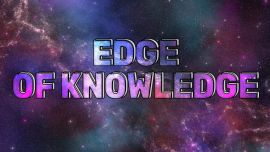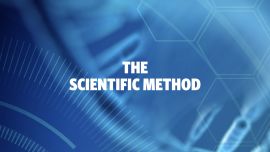00:00
The Earth formed about 4.5 billion years ago
00:03
and life appeared on our planet
00:05
about 3.5 billion years ago,
00:07
and probably even earlier.
00:09
That's a remarkably short amount of time
00:11
for our world to go from dead to alive.
00:15
And while we know that this process happened,
00:17
we're not exactly sure how,
00:20
and figuring it out involves stretching
00:22
the very definition of life itself.
00:35
The early Earth was terrible for life.
00:38
I mean, when it first formed,
00:39
it was literally a ball of molten rock,
00:43
which is the very definition of inhospitable.
00:46
don't get me started on the young Sun.
00:49
It would constantly emit flares of radiation
00:51
that would just irradiate the entire solar system.
00:54
And even after things started to cool off,
00:56
our Earth suffered countless collisions
00:58
from asteroids and comets
01:00
that would just bombard the surface again,
01:08
making the place very difficult for life to gain a foothold.
01:12
But eventually things started to settle down.
01:14
The planet cooled off,
01:17
the oceans rose to the surface,
01:19
and the conditions for life were there.
01:22
Now, life needed three things to get started.
01:24
One, it needed a stable environment.
01:27
Two, it needed a soup of organic molecules
01:30
for its building blocks.
01:31
And it needed a source of energy.
01:33
So, where on the early Earth
01:35
could these conditions have been met?
01:38
Well, thankfully, our planet is a pretty big place
01:40
and there are lots of options that meet this criteria.
01:43
For example, there could be hydrothermal vents
01:47
This is a source of energy,
01:49
it has the right chemical mix,
01:50
and is a stable environment.
01:52
Or it could be hot springs, shallow or deep,
01:55
anywhere on the surface of the Earth.
01:57
Or even tidal pools that are sloshing in and out.
02:01
This could be the home
02:03
for the first life to appear on Earth.
02:05
There's even more radical suggestions,
02:07
like maybe beaches that were struck by lightning,
02:10
providing the right kind of chemical mix
02:11
and the source of energy.
02:13
Or maybe it all happened deep underground.
02:16
We honestly don't know yet which one of these places
02:19
is more likely than the other
02:21
to be the home for the first kind of life on Earth.
02:25
But was the earliest life on Earth even alive, man?
02:30
Well, there's over 100 possible definitions
02:34
And perhaps the most useful one for this context
02:37
is that life is a self-sustaining chemical reaction
02:40
that is subject to Darwinian evolution.
02:43
That means you, Charlie.
02:44
Don't worry, we'll come back to you.
02:46
This is an incredibly broad definition,
02:48
but we need this broadness to explore the origins of life.
02:52
Because today in the modern world,
02:54
this is obvious that you, or me, or potatoes are alive,
02:59
and that rocks are not.
03:01
The origins of life by definition
03:03
straddle the boundary between these two extremes.
03:06
And so, we need a very broad definition
03:08
to explore those origins.
03:11
So, how do a bunch of random chemicals
03:13
find themselves subject to Darwinian evolution?
03:16
Well, to do that, they need to perform three things.
03:19
One, they need to store information.
03:22
They need to keep some sort of memory
03:24
about who they are and what they're capable of doing.
03:27
Next, they need to catalyze reactions.
03:30
This is AKA metabolism,
03:32
and what makes life so much fun.
03:34
And lastly, they need to be able to self-replicate.
03:38
They need to be able make copies of themselves
03:41
so that they can remember who they are
03:43
and what they're capable of doing,
03:45
and pass all that onto a new generation.
03:48
Modern life uses a set of three macromolecules
03:52
to get all those jobs done.
03:54
One, we have our DNA, which is our store of information.
03:58
The DNA creates RNA, which transcribes that information
04:03
and then manufactures proteins.
04:05
And the proteins are the ones
04:07
who do the job of catalyzing reactions,
04:10
including replicating DNA so it can make copies of itself.
04:14
And this is an extraordinarily complex interaction
04:18
that honestly we don't fully understand.
04:21
And it's so complex and interconnected
04:24
that it's obvious that early life must have been simpler.
04:28
And it's possible that early life
04:30
didn't even use proteins or DNA.
04:34
It's possible that early life only used RNA.
04:38
This is called the RNA world hypothesis,
04:41
and it works because RNA is capable of self-replicating.
04:46
It's capable of catalyzing reactions.
04:48
And it's capable of storing information,
04:51
just not as efficiently as the full RNA DNA protein combo.
04:56
And most critically,
04:57
RNA is capable of something called autocatalysis.
05:01
Now, that's a $5 word if I've ever heard one.
05:03
Autocatalysis is the ability for a chemical
05:06
to catalyze reactions that generate copies
05:09
of the original molecule.
05:11
This is what enables RNA to participate
05:13
in the whole Darwinian evolution game.
05:16
So, in this timeline, the Earth is saturated
05:20
with a whole bunch of organic compounds.
05:22
And it's a pretty gross place if you ask me.
05:25
But eventually, short RNA strands appear.
05:28
And then, these short RNA strands
05:29
start participating in chemical reactions
05:32
that get ever more complex.
05:34
And then, slowly over time due to evolutionary pressure,
05:38
eventually DNA and proteins emerge
05:41
as more efficient versions of the same basic process.
05:44
And then, boom, you've got modern life.
05:47
While the RNA world hypothesis is appealing and intriguing,
05:51
it does have its shortcomings,
05:53
just like any scientific hypothesis really.
05:56
For one, we're not exactly sure
05:58
how RNA is supposed to do all this.
06:00
And RNA is very fragile,
06:03
a lot less robust than DNA.
06:05
So, it's not clear that it could actually survive
06:07
long enough in the early Earth.
06:09
This model just assumes that all the interesting metabolism
06:13
just sort of happens eventually.
06:15
This is just one idea of many.
06:17
We can use the branches of the evolutionary tree of life
06:21
to figure out what our earliest common ancestor was like.
06:26
Let's hit the chalkboard.
06:28
The entire tree of life,
06:31
and we can trace its origins back to a single comet.
06:36
Very funny, Charlie.
06:38
Why don't you just hang out in the corner here, okay?
06:41
That's nice, very funny.
06:42
We can sequence all extant life on Earth.
06:46
We can examine their genes and look for commonalities.
06:49
From the eukaryotes, including the animals
06:51
and Great Grandma Maude is somewhere up here,
06:54
and the plants and the flagellates.
06:56
We can look at the archaea.
06:57
We can look at all the bacteria,
06:59
and there are a lot of bacteria,
07:02
to see what few genes we have in common.
07:05
And this kinds of sequencing
07:07
has revealed about 330 genes that all life on Earth shares.
07:13
This is something we all have in common across the globe.
07:18
And we can use that to reconstruct something we call LUCA,
07:26
the last universal common ancestor.
07:29
Now, this is not the earliest life to appear on Earth.
07:34
But it is the common origin point for all modern day life.
07:39
And by looking at those genes,
07:42
we can figure out what LUCA looked like.
07:49
synthesized proteins to have metabolism,
07:52
was very heat-tolerant,
07:54
and probably lived in a deep sea hydrothermal vent.
07:58
This is our common ancestor that shared
08:01
our same biomechanical chemistry.
08:04
But to push back to even further generations,
08:07
we need to bring in an expert.
08:11
Thanks so much for doing this.
08:13
This is gonna be a lot of fun. No problem.
08:14
What is the earliest evidence for life,
08:18
and then the earliest debatable evidence for life?
08:22
One of the earliest pieces of evidence for life
08:25
is in rocks in Australia.
08:26
There are clear deposits that are carbon-rich
08:30
and physically shaped like bacterial formations
08:35
So, we assume it was early bacteria
08:37
living in a style that we can recognize still.
08:40
It's called a stromatolite,
08:42
a giant mound of bacteria that grow in layers
08:46
on top of each other.
08:47
It forms in watery environments.
08:50
And when you've got a shallow pond,
08:52
the bacteria just start growing up in a cluster
08:54
and eventually build up layer-on-layer
08:57
on top of each other until they form an entire mound.
09:00
Similar to modern life,
09:02
or do we think it was perhaps some chemically different?
09:05
It was almost certainly very similar to modern life,
09:09
in terms of the biochemistry of it all.
09:11
DNA, RNA, and proteins were almost certainly there.
09:14
What was the energy source for these kinds of bacteria?
09:18
Geological processes will produce chemicals
09:22
that bacteria can harvest energy from.
09:24
We also see that today in the deep sea vents.
09:27
Are you aware of these debates
09:29
when it comes to the origin of life
09:30
between replication-first scenarios
09:33
and metabolism-first scenarios?
09:35
There's two ideas about how life came about.
09:38
One is to think that you needed a metabolism.
09:42
Basically, some way of taking environmental energy
09:46
and converting it into useful chemistry.
09:48
If you have the metabolism,
09:50
then the rest of the cell, the genetics, the membrane,
09:54
the things that maintain that metabolism,
09:57
can build up around a chemical process
10:00
that's already happening.
10:01
And it's possible that life
10:03
just sort of built up around that.
10:05
The alternative is that through processes
10:09
that are energetically favorable,
10:11
you created a genetic material.
10:14
And the genetic material, in order to self-sustain,
10:17
evolved a way to harvest energy later.
10:20
I tend to favor genetics first.
10:22
I think forming a self-replicating molecule
10:26
is harder than having chemical processes
10:31
that sort of extract a little energy from the environment.
10:34
And so, I think the harder step had to come first.
10:38
What is the most stable environment
10:41
to allow these fragile chemicals to sustain themselves?
10:45
Something like RNA is very fragile in our present world
10:48
'cause everything views it either as food or as a threat.
10:52
So, there's lots of ways to digest RNA.
10:54
But back when it was forming,
10:56
none of those enzymes that would digest it existed.
10:59
And it's probably more stable than we give it credit for.
11:03
What matters is its ability
11:04
to self-replicate before it decays, and maintain
11:08
that genetic memory. Exactly.
11:09
Some of the environments they're proposing,
11:12
like deep sea vents,
11:13
those exist in chains over hundreds of kilometers.
11:17
The potential to produce the raw materials is huge.
11:20
It's not one little test tube in a lab.
11:23
Right, it's billions of test tubes over the course
11:26
of potentially hundreds of millions of years.
11:29
When did DNA happen?
11:31
DNA chemically is only one atom different from RNA.
11:36
Since DNA is more stable,
11:38
there would be an evolutionary selection
11:41
towards having a more stable repository
11:43
for genetic material.
11:46
And it's possible that there is an intermediate state,
11:49
where the chemistry wasn't picky
11:51
and used both DNA and RNA at the same time.
11:54
Last thing that's exciting to me
11:57
is that people have been working on minimizing
12:01
the genome of a bacteria.
12:03
How few genes can you get away with?
12:06
And one of the things they're thinking of doing
12:08
is once you have this fully minimized genome,
12:12
can you start taking out a protein
12:14
and replacing it with catalytic RNA?
12:17
So, have a sort of hybrid system.
12:21
There's lots of proteins around.
12:23
But some of the key reactions are done by RNA
12:25
instead of proteins.
12:27
That would reflect what we think would look like
12:30
a key intermediate step
12:31
before the last common ancestor of all life.
12:34
Would you even call
12:37
these kinds of chemical reactions alive?
12:40
Defining what life is is a really challenging thing.
12:45
We tend to look for binary definitions.
12:48
Is it alive or not?
12:50
Is it a species or not?
12:51
And life doesn't necessarily give us the clean answer.
12:55
Is the origins of life
12:57
potentially incredibly messy,
12:58
as messy as life itself?
13:01
And I think that's something
13:03
that people don't necessarily appreciate
13:06
about this sort of research.
13:08
We're never gonna go back in time
13:10
to figure out exactly how life came together.
13:12
And so, what scientists are trying to do
13:15
is put together a whole set of plausible pathways
13:21
that could produce something that's living.
13:24
And we won't know whether that is exactly how life started,
13:30
but what we would know is that it is possible to form life
13:35
with simple chemistry.
13:37
That's gonna be a mix of different answers
13:39
that are satisfying to different degrees.
13:42
It happened here on Earth.
13:44
Did it happen on our sibling planets too?
13:47
We can make some inferences
13:48
based on what we know about them today,
13:51
about what they looked like in the past.
13:53
That lets us make some guesses
13:55
about what might be happening on these other planets.
14:00
It's also plausible
14:01
that something we would recognize as life
14:03
could have significantly different chemistries.
14:06
We've only got one example of life to work with.
14:09
And so, our biases are towards
14:11
what can we find that looks like what we know works.
14:15
Thank you so much for joining us.
14:17
It was a joy to have you and I can't wait to have you back.
14:22
Our exploration for the origins of life
14:24
have taken us all across the globe,
14:27
into the stars themselves.
14:28
And we've had to combine biology, chemistry, geology,
14:33
and even astronomy to understand our own origins.
14:37
And really, that search is just beginning,
14:40
unlike this episode, which is over.
















